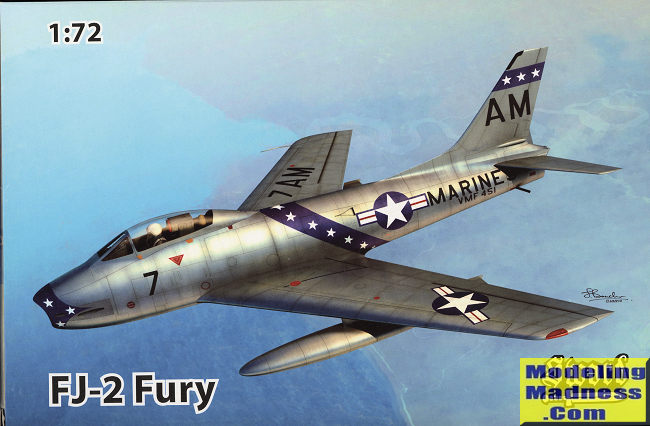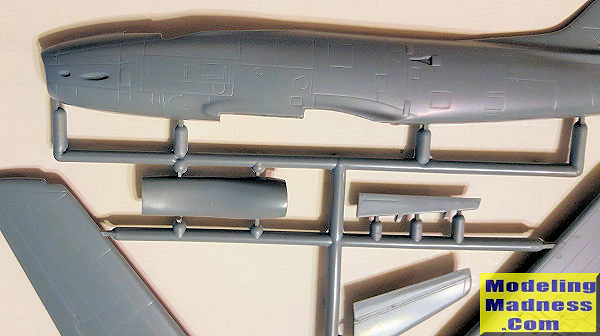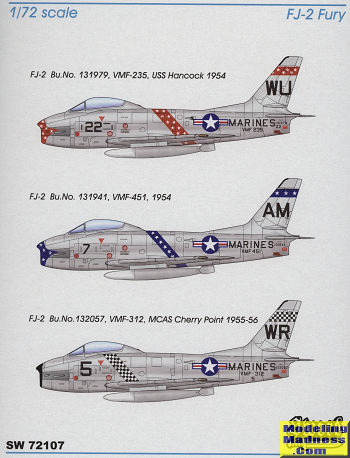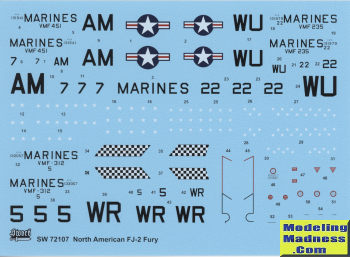
Sword 1/72 FJ-2 Fury
| KIT #: | SW 72107 |
| PRICE: | $18.00 plus shipping |
| DECALS: | Three options |
| REVIEWER: | Scott Van Aken |
| NOTES: | Short run kit with resin parts. 2017 tooling. |

| HISTORY |
The North American FJ-2 and FJ-3 Fury were a series of swept-wing carrier-capable fighters for the United States Navy and Marine Corps. The FJ-2 resulted from an effort to navalize the United States Air Force's F-86 Sabre. These aircraft featured folding wings, and a longer nose landing strut designed to increase angle of attack upon launch and to accommodate a longer oleo to absorb the shock of hard landings on an aircraft carrier deck.
Although sharing a U.S. Navy designation with its distant predecessor, the straight-winged North American FJ-1 Fury, the FJ-2/-3 were completely different aircraft. (The later FJ-4 Fury was, again, a complete structural redesign of the FJ-3). The FJ-2 was one of the aircraft used to evaluate the first steam catapult on a US Navy aircraft-carrier.
By 1951, the Navy's existing straight-wing fighters were much inferior in performance to the swept-wing Soviet MiG-15 then operating in the Korean War; the swept-wing fighters in the Navy's development pipeline, including the Vought F7U Cutlass and F9F Cougar, were not yet ready for deployment.
As an interim measure, the Navy's Bureau of Aeronautics ordered a direct development of the swept-wing F-86E Sabres as the FJ-2. As the F-86 had not been designed to be carrier-capable, this involved some risk, but Navy pilots had observed that the F-86A actually had a lower landing speed than the F9F Panther. During carrier qualification trials the Navy informed Grumman that if the F9F-5 stall speed was not reduced by 12 mph (10 kn; 19 km/h) it would be removed from carrier operations at the same time that the FJ-2 was already making its debut into Navy squadrons. North American's chief engineer at the time stated that the swept wing Sabre had handling and stall characteristics at low speeds comparable to the best straight winged airplanes. The urgency behind the program was such that 300 (later reduced to 200) FJ-2 fighters were ordered before the prototypes had flown.
The first prototype to fly was actually the third aircraft ordered: Designated XFJ-2B and first flown on 27 December 1951, it differed only from a standard F-86E-10 in its armament, having four 20-mm Colt Mk 12 cannon instead of the six Colt-Browning M3 .50 machine guns of the Sabre. The second and third aircraft to fly were designated XFJ-2 and lacked armament, but were modified to be carrier-capable: They had an arrester hook and a longer nosewheel leg to increase angle of attack at take-off and landing, and catapult fittings. In August 1952 carrier trials were flown on USS Midway, followed by carrier qualification trials on USS Coral Sea in October–December 1952. Results were less than satisfactory. Low-speed handling was considered poor, and the arrester hook and nose gear leg were insufficiently strong.
The first production aircraft flew on 22 November 1952. This FJ-2 incorporated further modifications for carrier operations: The track of the main landing gear was widened by eight inches, the outer wing panels folded upward, and the windscreen was modified to give the pilot a better view during approach. The FJ-2 also featured an all-moving "flying tail" without dihedral. Because of problems experienced during launches with steam catapults, a number of FJ-2 later received a stronger nosewheel strut. Outwardly, the FJ-2 was hard to distinguish from an F-86, apart from Navy paint and the gun muzzles of the 20 mm cannon. The engine was the General Electric J47-GE-2, a navalized version of the J47-GE-27 used in the F-86F. The naval modifications of the FJ-2 had increased weight by about 500 kg over the F-86F, but unfortunately had not succeeded in delivering a fully carrier-capable fighter. A decision had already been made to give it to land-based squadrons of the US Marine Corps.
Construction was slowed due to demand for the F-86 in Korea; the FJ-2 was not produced in large numbers until after that conflict had concluded. Only seven aircraft had been delivered by then end of 1953, and it was January 1954 before the first aircraft was delivered to a Marine squadron, VMF-122. The Navy preferred the lighter F9F Cougar due to its superior slow-speed performance for carrier operations, and the 200 FJ-2 models built were delivered to the United States Marine Corps. The Marines did make several cruises aboard carriers and tried to solve the type's carrier handling problems, but the FJ-2 was never really satisfactory. In 1956, the FJ-2 already disappeared from front-line service, and reserve units retired it in 1957.
| THE KIT |

 with a tub that has raised side console
detail and the rudder pedals molded in place. There is a raised detail
instrument panel, a control stick and a back bulkhead that also serves to
provide an attachment point for the intake. The only resin in the kit is the two
piece bang seat.
with a tub that has raised side console
detail and the rudder pedals molded in place. There is a raised detail
instrument panel, a control stick and a back bulkhead that also serves to
provide an attachment point for the intake. The only resin in the kit is the two
piece bang seat.
 Instructions
are well done with generic pai
Instructions
are well done with generic pai nted
by the builder. You'd think that something as simple as fuselage and tail
stripes could be provided in color, but nope. Even more difficult for many will
be the nose scallops. All the stars are provided so you 'simply' attach them
once you've done the painting. The first option is with VMF-235 while the second
is with VMF-451. Most modelers will choose not the go through the hassle of
painting the bands and scallops and choose the third option with VMF-312 as
those bands are provided. One will only have to mask off and paint the nose
black. Decals are quite nicely done and should provide no issues.
nted
by the builder. You'd think that something as simple as fuselage and tail
stripes could be provided in color, but nope. Even more difficult for many will
be the nose scallops. All the stars are provided so you 'simply' attach them
once you've done the painting. The first option is with VMF-235 while the second
is with VMF-451. Most modelers will choose not the go through the hassle of
painting the bands and scallops and choose the third option with VMF-312 as
those bands are provided. One will only have to mask off and paint the nose
black. Decals are quite nicely done and should provide no issues.
| CONCLUSIONS |
| REFERENCES |
https://en.wikipedia.org/wiki/North_American_FJ-2/-3_Fury
November 2017
Copyright Modeling Madness.com. All rights reserved
If you would like your product reviewed fairly and fairly quickly, please contact the editor or see other details in the Note to Contributors.
Back to the Main Page Back to the Review Index Page Back to the Previews Index Page